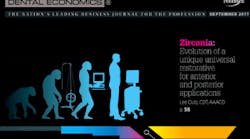"Future historians will undoubtedly mark the year 2017 as falling within a unique period of economic transition. ... The dental profession and industry are already beginning to feel the effects of the Third Industrial Revolution" ... as technology continues to evolve.
Future historians will undoubtedly mark the year 2017 as falling within a unique period of economic transition. The ways in which our society powers, produces, and transports its goods and services are always evolving, but there are notable eras of rapid growth that are marked with substantial amounts of both progress and chaos. Indeed, it is appropriate to call these times a “revolution.”
The First Industrial Revolution extended from the mid-eighteenth century to the early nineteenth century. It was powered by steam, machines began to replace manpower, and early railways and canals transported people and goods farther and faster than ever before.
The Second Industrial Revolution began in the late nineteenth century, and we are arguably still reeling from its effects. Oil, steel, and electricity led to more sophisticated construction and manufacturing. The telegraph begat the telephone, and we girdled the globe with roads for our automobiles. How fast did technology evolve? After the first successful flight by the Wright brothers, it took only 66 years for a man to set foot on the moon.
These industrial revolutions are not without their casualties. When we discover cheaper, faster, and better ways to do something, we rarely have patience for processes that we perceive to be more expensive, slower, and of lower quality. The First and Second Industrial Revolutions left a lot of craft workers and horses out of jobs.
In Jeremy Rifkin’s 2011 book, The Third Industrial Revolution,(1) we are presented with the theory that we are entering the next great period of economic transformation. This time, digital communication combines with renewable energy sources and automated modes of transportation. It’s not very hard to imagine a person ordering a driverless, electric-powered car via a smartphone. Think about how these unstoppable technological advances will affect our economy, both positively and negatively.
The dental profession and industry are already beginning to feel the effects of the Third Industrial Revolution. The work of skilled dental technicians is being replaced with CAD/CAM and 3-D printing. Digital impressions are gaining ground on physical ones. Our patients will continue to demand that we provide their care cheaper and faster without sacrificing quality.
I believe professions must hold themselves to higher expectations than simply what the market demands. We must be the ones to set the standard of care. But at the same time, we must pay attention to the economic revolution going on around us. If technology permits us to provide care that is the same or better quality, then we should take advantage of the speed and affordability that come along with it.
Cheers,
Chris Salierno, DDS
Reference
1. Rifkin J. The Third Industrial Revolution: How Lateral Power Is Transforming Energy, the Economy, and the World. New York, NY: St. Martin’s Press; 2011.









